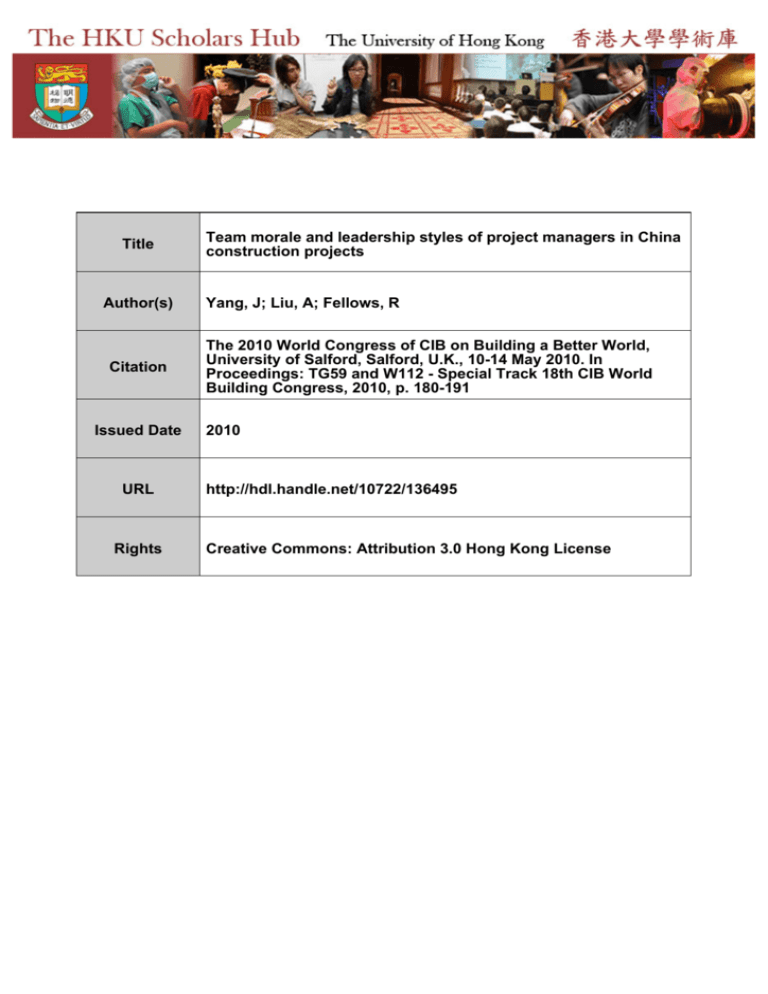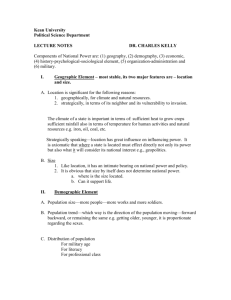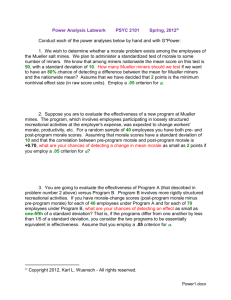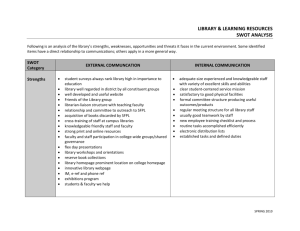Team Morale and Leadership Styles of Project Managers in China
advertisement

Title Author(s) Citation Issued Date URL Rights Team morale and leadership styles of project managers in China construction projects Yang, J; Liu, A; Fellows, R The 2010 World Congress of CIB on Building a Better World, University of Salford, Salford, U.K., 10-14 May 2010. In Proceedings: TG59 and W112 - Special Track 18th CIB World Building Congress, 2010, p. 180-191 2010 http://hdl.handle.net/10722/136495 Creative Commons: Attribution 3.0 Hong Kong License Team Morale and Leadership Styles of Project Managers in China Construction Projects Yang, J. University of Hong Kong, China (email: jyang@hkusua.hku.hk) Liu, A. Loughborough University, UK (email: a.m.m.liu@lboro.ac.uk) Fellows, R. Loughborough University, UK (email: r.fellows@lboro.ac.uk) Abstract The relationships of project team morale and the supervisory styles of project leaders are examined in this paper based on P-M theories which assume dichotomous styles of performance-oriented and maintenance-oriented leadership. In P-M theories, leadership affects motivational arousal directly through a combination of pressure and support where the work structuring aspects of leadership, which affect motivation by clarifying paths to goals, are less central. Generally, previous research supported both P- and M-oriented leadership styles being consistently and positively related to organisational performance measures, although the M-oriented style of leadership was found to be more effective in functional organisations and P-oriented leadership was more effective in the engineering project field of temporary organisations. Situational contingencies in this study are assumed to affect subordinates’ interpretations of leadership primarily, i.e. the leadership styles reported by subordinates are assumed not to reflect the objective level of leadership behaviour. Instead, those measures reflect the amount of a leadership function that subordinates experience given their own personalities, cultural background and the situational contingencies that they face. The subjects in an exploratory study of joint venture projects in China reported in this paper reflect the influence of leadership styles on the level of team morale and project time performance in given sets of situational contingencies. Keywords: leadership style, project leader, team morale 180 1. Introduction The project supervision system in China defines the status of the project leader (supervision engineer) and provided the framework for developing roles and functions of various project participants. The relationships of project team morale and the supervisory styles of project leaders are examined in this paper based on P-M (performance – maintenance) theories which assume dichotomous styles of performance-oriented and maintenance-oriented leadership. The subjects in an exploratory study of joint venture projects in China reported in this paper reflect the contextual meaning of leadership styles through the elicited responses on the level of team morale and project time performance in the given set of situational contingencies where culture plays a role in the adoption of leadership style through the ‘intercultural adjustments’ by expatriate project leaders in China. The research objectives are: 1. to investigate the effects of performance-maintenance leadership on team morale, and 2. to investigate the project situational context – the time-completion criterion in joint venture projects – in which the leadership influences team morale. 2. Project procurement in China In order to understand the project management practice in China, it is necessary to explain the managerial mechanism and particular relationships among the participants such as the government authorities, the clients and the contractors. There are many other organisations that participate directly or indirectly in the project procurement activities, e.g. banks, suppliers, manufacturers, insurance companies, the supervisor or supervision engineer (otherwise known as project manager in the West), and the designers (equivalent to the professional consultancy team). Despite recent economic reforms to decrease the number of state-owned enterprises (SOE), a large number still exists, especially in major industries such as metallurgical, petrochemical, chemical enterprises, communication and transportation. Central government delegates different ministries the power to regulate these SOEs. The management of these corporations is undertaken by the responsible bureaux and the ministries in the government. The Ministry of Construction was renamed the Ministry of Housing and Urban-Rural Development (MoHURD) in 2008 and is under the administration of the State Council of China. By 2006, there were 60,166 construction enterprises employing 28,781,600 persons (http://www.stats.gov.cn/tjsj/ndsj/2007/indexeh.htm; accessed February 2009). As the construction industry developed, there was an increase in the non-state-owned construction enterprises in the 80s, 181 e.g. the collectives under the responsibility system and some privately owned enterprises. The restructuring of ownership of firms is reviewed in Han and Ofori (2001). Further changes occurred after China’s accession to the WTO. In 2002, market access was opened to foreign enterprises through the Foreign Investment Design Enterprises Regulations and the Foreign Investment Construction Enterprises Regulations, e.g. since 2004, exclusively foreign-owned construction firms are allowed to carry out work on four approved types of construction projects; and since 2006, exclusively foreign-owned design consulting firms are allowed to practise. Enterprises can now be categorized into: • State-owned enterprises (SOE) • Collective-owned enterprises • Shareholding/limited companies • Private • Others: e.g. foreign –owned (partial or full) enterprises The major changes since the 80s are that (1) the establishment of the tendering system has transformed the industry (from undertaking solely state-allocated projects) to undertake privateinvestment commercial projects; (2) the formation of the Project Supervision System, which represents the national model in project management, has led to consolidation of standard contracts, management standards, construction safety standards etc. and encouraged the development of other professional disciplines in construction. China has developed the Project Supervision System (PS) for 20 years since 1988. The PS system, which is sometimes known as the Agent System, began as a construction quality supervision system. However, the current Agent System has transformed into a holistic management system which encompasses every aspect of project construction supervision /management, e.g. briefing, programming, design, tendering, construction and post-construction maintenance. The professional team develops the technical and engineering design according to the specifications and cost limit in the approved feasibility study. In order to comply with the law and state policy, every client must employ an organisation to undertake the duty of project supervision (or project management). The scope of supervision duties can be design supervision, purchasing and supplying supervision, construction supervision or any mixture of these. The supervisor acts as an independent representative of the client to supervise and monitor the implementation of project activities. Usually, the bidding for construction begins after the completion of preliminary design. The client and/or the supervisor prepare the bidding brief. At present, there are three approaches: public (open), nominated (selective), and negotiated. For large or medium scale industrial projects which are funded by the government or domestic clients, nominated bidding (selective tendering) is the most common method. For building projects and other smaller projects, public bidding (open tendering) is usually employed. 182 As for those specialised projects such as military defence in which special construction techniques are required, the contracts may be negotiated. In the construction stage, the management and implementation of construction works are the predominant activities. The government stipulates that only after the client obtains “the license for construction project” can the construction activities begin. At the completion stage, the client, the supervisor, the professional team and other specialists from the institutional authorities check and appraise the performance of the contractors in terms of the quality, cost and completion time of the works. In recent years, there has been a rapid development in the field of project management – project leadership has been given much research attention in China. 3. Leadership theories and team morale The concept of leadership theory lies in the possibility of labelling and objectifying an otherwise confusing diversity of behaviours. Such precision would be particularly attractive if it allowed generalisations about leader behaviours within differing organisations (as exist in the ministerial corporations environment) and/or different cultural contexts (as often the case in international project procurement). Managerial tasks are inherently hectic, diversified and reactive (e.g., Kanter 1983). Much research investigates the relationship between managers’ behaviours and outcomes of managerial tasks, i.e. the objective criteria for measuring leadership effectiveness such as subordinates’ satisfaction and work performance. The assumption is that “supervisor styles achieve their impact only insofar as they are perceived by subordinates and others toward whom supervisors address themselves” (Tayeb 1995). Most of these behavioural research are based on pioneering studies performed in the Ohio State University during the 1950s which identified relevant facets of leadership by means of factor analysis (the Leader Behaviour Description Questionnaire LBDQ and Supervisory Behaviour Description Questionnaire SBDQ) (Hemphill 1950; Halpin and Winer, 1952). Subordinates usually perceived their supervisor’s behaviour in two distinct categories (Fleishman, 1953; Halpin and Winer, 1957)), task-oriented (i.e. the initiating structure) and relationship-oriented (i.e. consideration). The initiating structure consists of those activities which the supervisor engages in defining and structuring the various tasks and roles of team members in order to attain group goals and fulfil organisational mission. Consideration refers to those activities toward subordinates that aim at maintaining good relationship, mutual trust, openness and understanding. Related development includes work of Fiedler (1967), Stogdill (1963) and Misumi (1985). Misumi (1985) and his colleagues (see Misumi and Peterson 1985) develop a taxonomy of P-M supervisory styles based on decades of research in Japan. P-style is performance-oriented and M-style is maintenance-oriented. The former is the function of contributing toward a goal achievement or problem solving, and the latter is that of promoting a group’s self preservation or of maintaining and strengthening the group process itself. The multiplicative functions of P and M behaviour contribute towards the effectiveness of managerial activities (Misumi 1985, Misumi and Peterson 1985). 183 The theoretical roots of the PM function-based conception of leadership lie in the symbolic interactionism and in the structural functionalism that characterised group dynamics research of the 1950s and 60s (see Cartwright and Zander 1968). The PM theory of leadership suggests that a person’s contribution to fulfilling one of these functions supports or ‘catalyses’ the effects of fulfilling the other, i.e. the two functions are not conceptually viewed as separate dimensions but as abstractions which provide a way to describe integrated leadership types. House (1987) argues that the PM theory’s ‘above average – above average’ representation of leadership is empirically quite different from the ‘high-high’ representations of leadership in analogous U.S. research (Blake and Mouton 1982). PM theory also differs from Western research traditions in the intervening processes and criteria emphasised for explaining the effects of leadership. In PM theory, leadership affects motivational arousal directly through a combination of pressure and support. The work structuring aspects of leadership that affect motivation by clarifying paths to goals are less central to the PM theory (Hersey and Blanchard 1982). Since every leader emanates actions which can be categorised into P-oriented or M-oriented style, the differences across different leaders in the P-M taxonomy are merely quantitative and not qualitative. Thus, the leaders can be classified into four subsets of pm, pM or M, Pm or P, and PM. The pm leaders show no conscious effort in management (such as laissez-faire), the M leaders emphasise Moriented activities and show less concern in P-oriented activities, the P style leaders focus upon Poriented behaviours rather than M-oriented behaviours, the PM style leaders display both distinct Poriented and M-oriented behaviours. According to Misumi (1985), both P- and M-oriented leadership are consistently and positively related to organisational performance measures, i.e. those leaders display P-oriented and/or M-oriented behaviours seem to be associated with higher organisational performance. Morale is generally regarded as a state of individual psychological well-being based upon a sense of confidence and usefulness and purpose, it denotes a spirit, as of dedication to a common goal, that unites a group (www.thefreedictionary.com/morale). Thus, morale is “the state of the spirits of a person or group as exhibited by confidence, cheerfulness, discipline, and willingness to perform assigned tasks”. Morale is a motivational construct defined by Baynes (1967) and Mannings (1991) as the enthusiasm and persistence with which a group member engages in prescribed unit. The impact of leaders’ behaviour on subordinates’ attitudes and performance has typically been addressed in the context of a single leader’s influence on individuals or units. Mael and Alderks (1993) examine situations in which multiple leaders of a unit form a leadership team – multiple leaders who are arrayed hierarchically or laterally – as in a military platoon, and suggest that leaders should pay more attention to the impact their cohesion or dissension may have on team morale and performance. According to Mael and Alderks (1993), while loss of harmony leads to dissension and nullify horizontal bonding, cohesive leadership improves members’ confidence in the team and perceptions of team effectiveness. Previous research findings have also shown the relationship of team morale with leadership styles and stress etc. (e.g. Misumi, 1985; Brooker, Molyneux, Deverill and Repper, 1999). For instance, morale factors from Misumi (1985), with which a relationship with leadership style is found, include 184 motivators, job satisfaction, satisfaction with compensation, satisfaction with teamwork, group meeting quality, communication adequacy, mental health and performance norms. Furthermore, Oliver’s (1988, cited in Mael and Alderks, 1993) meta-analysis finds a relationship between group cohesion and unit performance. Hence, a decrease in motivation, organisational identification and intent to remain (commitment) in the organisation could be expected if there are negative attitudes among members in team cohesion because of lack of / insufficiency in leadership (Mael and Alderks, 1993). 4. Research approach 4.1 Data collection instrument As Misumi’s (1985) research was based on the Japanese, their questionnaire was more appropriate to be adopted in this study for the Chinese community with a similar Asian management philosophy. The main target respondents of this research were project managers and their project team members working in Chinese mainland for foreign construction companies on joint venture projects. The Misumi questionnaire which measured (1) morale factors and (2) leadership style was used for data collection. The sample of respondents came from joint venture (JV) or wholly-owned foreign projects under construction in Bejing in 2006. From a preliminary search on the internet and local press release, there were around 40 JV/foreign owned project organisations at the time and 30 of them were approached. A total of 10 such organisations, with a portfolio of around 50 projects, agreed to participate in this research. This study was based on 23 projects undertaken by 10 JV/foreign owned organisations in Beijing. There were 184 project participants eligible as respondents to whom the questionnaire was sent. A total of 59 responded, a response rate of 32%. In Misumi’s (1985) study, planning and performance questions correspond to ‘planning, control and coordination’ behaviours, and maintenance questions correspond to behaviours which are seen as ‘supporting team members and showing consideration for people’. The leadership styles are defined by calculating the total score of respective performance and maintenance related questions. If the leader has a P score higher than the average P score of all the respondents, then s/he is a P-style leader. Project managers whose P and M scores both exceed the average are classified as PM leaders and those whose P and M scores fall short of the averages are the pm leaders. The remaining are those whose P scores exceed the average as P style leaders (or Pm) and those whose M scores exceed the average as M style leaders (or pM). Morale questions (Misumi, 1985) relate to the six factors of motivators, job satisfaction, satisfaction with compensation, satisfaction with teamwork, group meeting quality, communication adequacy. This study has omitted the two factors of mental health and performance norms as it is deemed inappropriate for the team members to assess the project leadership’s effect on these variables. 185 4.2 Data analysis Among the 10 JV/foreign owned organisations 6 were from European countries, i.e. Germany, Austria, Netherlands, and the UK. There were also 3 from Hong Kong and one from the USA. Two levels of analysis were carried out at individual-level and project-level. Individual-based analysis was carried out based on respondents’ morale scores and the leadership (style) scores of the leader of the project organisation that the individual belongs to. The respondents were treated as individual cases (as project team member) and the morale score of each respondent was obtained by adding up the scores of all the five morale factors. The project-based analysis was carried out at project level based on the leadership (style) score of the project manager and the project morale score was the average of morale scores of the project team members. 4.2.1 Individual-based analysis The correlation coefficients of leadership style and team morale factors are given in table 1. Morale factors are motivators, job satisfaction, satisfaction with compensation, satisfaction with teamwork, group meeting quality, and communication adequacy in Misumi’s (1985) questionnaire. The distribution of the 59 respondents by project organisation type and their team roles is given in Table 2. Table 1: Individual-based Analysis: Leadership Style and Team Morale Factors Correlations Motivator Compensatio n Teamwork Meeting satisfaction Communication adequacy .126 Morale score Individual-level (N=59) Leadership style M-oriented P-oriented .337(**) .319(*) .289(*) .096 .599(**) .480(**) .264(*) .091 .108 .145 .295(*) .081 .468( **) .047 .309(*) .552(**) .183 Individual-level excluding project managers and head office management staff (N=33)# Leadership style .473(**) .541(**) .275 -.011 .534(**) .503(**) M-oriented .645(**) .731(**) .420(*) .283 .707(**) .776(**) P-oriented .167 .223 .185 .105 -.007 .192 #Individual-level analysis excluding project managers (N=20) and head office management staff (N=6) * Correlation is significant at 0.05 level (2-tailed); ** Correlation is significant at 0.01 level (2-tailed) 186 Table 2: Distribution of Respondents’ Project Organization Type and Team Roles N % N % Project engineer 31 52.5 Wholly-owned foreign enterprise 42 71.2 Project manager 20 33.9 Joint Venture 15 25.4 Project management staff in head office 6 10.2 JV hold by State owned Chinese enterprise 2 3.4 Others 2 3.4 Total (no. of respondents) 59 100.0 Total (no. of respondents) 59 100.0 The correlation results show that leadership style (consisting of all the questions under P and M) has a significant relationship with team morale at the individual level, and that the maintenance(M)oriented, rather than the performance(P)-oriented, questions are responsible for this effect. 4.2.2 Project-based analysis There are 23 projects undertaken by the 10 organisations in this exploratory study. In total, there are 20 project managers involved (where some project managers are responsible for more than one project). Data presentation includes (1) morale scores (table 3) and (2) correlation of project leadership style with morale factors (table 4). Table 3: Mean Scores of Project member’s Morale Factors under Different Leadership Styles Leadershi Motivator p style Compensatio n Teamwork Meeting satisfaction Communication adequacy Morale score (total) PM 21.46 15.92 21.00 19.00 18.85 96.23 M 21.83 16.00 20.83 19.33 18.00 96.00 P 19.11 13.11 19.56 19.11 16.33 87.22 P 18.60 13.00 20.20 19.00 16.20 87.00 Table 4: Project-based Analysis: Leadership Style and Team Morale Factors Correlation s Motivator Compensatio n Teamwork Meeting satisfaction Communication adequacy Morale score Project-level (N=23) Leadership style M-oriented .402 .376 .477(*) -.112 .211 .407 .704(**) .617(**) .341 -.112 .426(*) .599(** ) .135 .087 .168 .137 .276 P-oriented .482(*) * Correlation is significant at 0.05 level (2-tailed); ** Correlation is significant at 0.01 level (2-tailed) 187 At the project level, although leadership style in general does not have a significant relationship with team morale, M-style bears a significant positive relationship with team morale. 4.2.3 Interviews Subsequent interviews are carried out with one purpose:Based on the finding that the PM style relates to the highest morale score, interviews are carried out to investigate whether the leadership styles are related to project outcome – in this case, project outcome is assessed as works completion time. Table 5: Completion Time and Leadership Style Leadership Style Project Status completed in advance PM P Total M Pm 1 0 0 0 1 5 2 4 0 11 on schedule (works in progress) 3 1 1 0 5 extension of time given 0 0 0 5 5 0 0 0 1 1 9 3 5 6 23 completed on time behind schedule (works in progress) Total (no. of projects) The interviews are carried out with the client’s site representative and project staff to explore whether the leadership style is associated with one of the project performance indicators, i.e., work progress within the time planned (Table 5). 5. Discussion It is too small a sample to analyse the national cultural traits with leadership style and this study is not designed for that purpose. However, questions are included to indicate a spread of the power distance profile of the managers to provide insight to formulating further research questions. Thus, data collection includes power distance which can be expressed in a Power Distance Index (PDI) following the same rationale adopted from the original research carried out by Hofstede in 1980. The theoretical range of the index is from -90 to +210. Low PDI indicates a perceived equality of ability, autonomy and independence, and high PDI indicates a prevalence for authoritarian, conformity and centralized decision making. The sample is small and the validity of the power distance calculated can be an issue if further analysis is based on it. Hence, no statistical analysis is further pursued and the PDI findings are: (1) the overall PDI mean value is 45.79, (2) the mean value of PDI for German project managers is 35.96, 188 for Hong Kong project managers is 47.5, for the American project manager is 85, for the Chinese project managers is 68.33, for Canadian project managers is 60, (3) based on the origin country of the company, mean values are 34.04 for German company, 85 for Hong Kong Company, 85 for American company, 26.67 for Dutch company, and 85 for Austrian company, (4) the German project managers’ PDI values range from a low of -15 to a high of 85, (5) the highest PDI is found for a Hong Kong project manager from a Hong Kong company (110), while the lowest is also found for a Hong Kong project manager but working in a Dutch company (-40). The result indicates that construction projects with western project managers often have lower PDI value compared to those with project managers from China and Hong Kong. This is consistent with result from previous research, e.g. Hofstede (1980) that western society has lower PDI. However, the high PDI for the American project manager is an exception. From the interview with his project staff, it is found that this project manager has worked in China for less than a month, the high PDI maybe due to language difficulty and other communication issues with his Chinese project staff. Schermerhorn Jr and Bond (1997) find that there is a relationship between power distance and followers’ behaviours, e.g. individualist moderate power distance leader finds collectivist and high power distance followers to be conforming, reserved, and with tendencies toward in-group agreement and groupthink. In this study, the scatter plot shows no relationship and it is inconclusive whether the PDI is correlated with leadership style (as this research is not designed with this objective). This exploratory study reveals that there can be a vast range of PDI in projects where the managers come from the same country (the German project managers’ PDI) but organisational culture may have a direct influence (the Hong Kong managers in a Dutch company and a Hong Kong company). Further research in the construction context, especially in international joint ventures, should be conducted. Recent research on empowerment within the project teams at the individual level and project level (Tuuli and Rowlinson, 2009) sheds light on the empowerment climate within the organisation which future research could build on. It is noted that the PM-style is related to the highest morale score and that M-style has a positive and significant effect on team morale. There are two limitations in this analysis. First, the correlation results of leadership style with team morale scores make use of the grouping of the maintenancerelated questions and the performance-related questions to correlate with the morale factors. It fails to show the PM-style correlation with team morale. Second, the sample in the individual-level analysis consists of all respondents (N=59), hence, a further analysis (N=33) excludes the project managers and the head office staff, thus leaving the project staff in the analysis. However, the sample of 33 is too small to draw conclusions, except to highlight issues to be further explored. It is recommended to carry out future study with a larger sample to analyse the project staff, excluding the project managers, at the project level. 6. Conclusion The leaders in this study are classified into four subsets of pm, M, P, and PM. The pm leaders show no conscious effort in management (such as laissez-faire), the M-style leaders emphasise relationship building/maintenance, the P-style leaders focus upon planning and performance behaviours, the PM 189 leaders display both distinct P-oriented and M-oriented behaviours. In this study, the highest morale score is associated with the PM style (followed by M, pm and P) and the least morale score with Pstyle, hence, the least effective leadership (in terms of fostering team morale) is from the performance-oriented leader. Correlation analysis at the individual level shows that team morale correlates with project manager’s leadership style and that the project manager’s maintenance (relationship) orientation, in particular, fosters team morale among the members. At the project level, the effect of leadership style on team morale is not significant although the project manager’s maintenance orientation is found to correlate significantly with team morale. Out of the 23 projects, there are nine projects with PM-leaders, five with M-leaders, three with Pleaders and six with pm-leaders. At the interviews with project staff and the clients’ representatives on site, it is found that out of the 23 projects, none of the pm-leaders are responsible for projects which have been completed on time whereas there are five projects with PM-leaders and four projects Mleaders which have timely completion. The pm leaders are responsible for the only project which is behind schedule and all the five projects which have been given ‘extension of time’. This study supports the findings of Misumi (1985) where those leaders who display P-oriented and/or M-oriented behaviours seem to be associated with higher organisational performance; alternatively, the pmleaders are associated with lower performance. Whether leadership style is associated with power distance as a national culture dimension is not investigated in this project. While Schermerhorn Jr and Bond (1997) have found such relationship, it is recommended to carry out future study with a larger sample at the project level to analyse the relationship of power distance and leadership in the sample of project teams. References Baynes (1967) Morale. New York: Praeger Blake, R. R., Mouton, J. S (1964) The managerial grid : key orientations for achieving production through people, Houston: Gulf Publishing Co. Brooker C., Molyneux P., Deverill M., Repper J. (1999) Evaluating clinical outcome and staff morale in a rehabilitation team for people with serious mental health problems. Journal of Advanced Nursing. 29, 1, 44-51 Cartwright D., Zander A.F. (ed.) Group dynamics: research and theory. Harper and Row Fiedler F.E. (1967), A theory of leadership effectiveness. McGraw Hill NY. Fleishman, E. A., (1953). The description of supervisory behavior. Personal Psychology, 37, p. 1-6. Halpin, A. W., & Winer, B. J., (1952). “Studies in Aircrew Composition III: the Leadership Behavior of the Airline Commander”, Technical Report No. 3 Columbus Ohio: Personnel Research Board, Ohio State University. 190 Han S.S., Ofori G. (2001), Construction industry in China’s regional economy, 1990-1998. Construction Management and Economics. 19, 2, 189-205 Hemphill J.K. (1950). Leader Behavior Description. Columbus Ohio: Personnel Research Board, Ohio State University. Hersey P., Blanchard K.H. (1982) Management of Organisational Behavior: utilising human resources, Englewood Cliffs, NJ.: Prentice Hall Hofstede, G.H (1980) Culture’s consequences: international differences in work-related values, Beverley Hills, CA.: Sage Publications House, R. J. (1971) A Path-Goal Theory of Leadership Effectiveness, Administrative Science Quarterly, 16, September, 321-338 Kanter, R. M. (1983). The change masters. New York: Simon & Schuster. Mael F.A. Alderks C.E. (1993) Leadership team cohesion and subordinate work unit morale and performance. Military Psychology. 5, 3, 141-158 Mannings F.J. (1991) Morale, cohesion and esprit de corps. In Gal R., Mangelsdorff A.D. (ed.) Handbook of military psychology. New York: Wiley. Misumi J. (1985), The behavioural science of leadership: an interdisciplinary Japanese research program. Ann Arbor, MI: University of Michigan Press. Misumi, J., Peterson, M. F. (1985) The performance-maintenance (PM) theory of leadership: Review of a Japanese research program, Administrative Science Quarterly, 30, 198-233 Oliver L.W. (1988) The relationship of group cohesion to group performance: a research integration attempt (Tech. Rep. No. 807). Alexandria, VA: U.S. Army Research Institute for the Behavioral and Social Sciences. (DTIC no. AD A199 069) Shdermerhorn J.r J.R., Bond M.H. (1997) Cross cultural leadership dynamics in collectivism and high power distance settings. Leadership and Organization Development Journal. 18, 4, 187-193 Stogdill, R. M., (1963). Manual for the leader behavior description questionnaire, Form XII. Columbus: Ohio State University. Bureau of Business Research Tayeb M. (1995), Supervisory styles and cultural contexts: a comparative study. Business Review, 4, 1, 75-89 International Tuuli M.M., Rowlinson S. (2009) Empowerment in project teams: a multilevel examination of the job performance implications. Construction Management and Economics. 27, 5, 473-498 191








